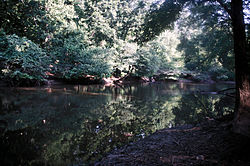Camden Expedition Sites
|
Camden Expedition Sites
|
|

Ferry crossing at Jenkins' Ferry Battlefield
|
|
| Location | Clark, Cleveland, Grant, Hempstead, Nevada, Ouachita counties, and possibly Pulaski County |
|---|---|
| NRHP Reference # | 70000127 |
| Designated NHLD | April 19, 1994 |
The Camden Expedition Sites are a National Historic Landmark District consisting of eight historic sites where events of the American Civil War's Camden Expedition occurred. The sites are spread across six or seven counties.
Each of the sites is individually listed on the National Register of Historic Places. The National Historic Landmark District was declared in 1994.
It is stated at the National Historic Landmark summary that there are nine sites included in the NHL, although that summary only lists only the above eight by name. The landmark nomination document clearly describes only eight sites. An Arkansas state webpage states that the Old U.S. Arsenal Building (meaning the Tower Building of the Little Rock Arsenal, in Little Rock, Pulaski County, Arkansas, where the expedition started) is included in the landmark. The photo set that accompanies the landmark nomination includes photos of the U.S. Arsenal Building as well as of the eight other sites, so it is unclear whether the Arsenal site is part of the landmark or not. It is unclear whether it was intended to be included but was dropped, or whether it was added after the nomination document was completed.
The 1864 Camden Expedition was part of a two-pronged strategy by the Union Army to drive Confederate resistance out of southwestern Arkansas and northern Louisiana, and to penetrate into Confederate Texas. Union Major General Frederick Steele led a Union force from Little Rock on March 23, 1864, with the objective of joining forces with Major General Nathaniel Prentice Banks at Shreveport, Louisiana. Confederate forces in Arkansas were directed from Washington, where the Confederate government of the state relocated after the fall of Little Rock. Confederate Major General Sterling Price ordered Brigadier General John S. Marmaduke to harry the Union column and to prevent it from crossing the Little Missouri River as it moved toward Washington. Advance Union forces established a beachhead on the south side of the Little Missouri on April 3, and clashed with Confederate defenders in the Battle of Elkin's Ferry. The outnumbered Confederates were forced to withdraw, and General Price established a defensive position, lightly fortified by earthworks, on the road between Elkin's Ferry and Washington at the western edge of the sparsely-populated Prairie d'Ane, a roughly circular area of prairie surrounded by woodlands.
...
Wikipedia
